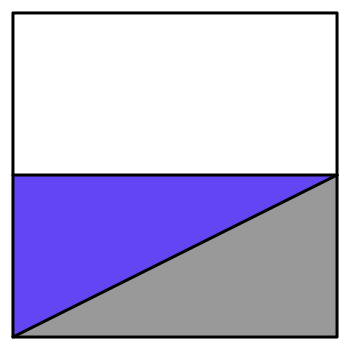Suppose that $X$ and $Y$ are two i.i.d. uniform random variables on the interval $[0,1]$
Let $Z=X/Y$, I am finding the cdf of $Z$, i.e. $ \Pr(Z\leq z) $.
Now, I came up with two ways of doing this. One produces a correct answer consistent with the pdf here: http://mathworld.wolfram.com/UniformRatioDistribution.html, the other does not. Why is the second method wrong?
First Method
$\newcommand{\rd}{\mathrm{d}} \Pr(Z\leq z) = \Pr(X/Y\leq z) = \Pr(X\leq zY) = \int^{1}_{0}\int^{\min(1,zy)}_{0} \rd x \rd y = \int^{1}_{0}\min(1,zy)\ \rd y$ $ = \left\{ \begin{array}{lr} \int^{1/z}_{0}zy\ \rd y + \int^{1}_{1/z} \rd y& : z > 1\\ \int^{1}_{0}zy\ \rd y & : z \leq 1 \end{array} \right. $ $ = \left\{ \begin{array}{lr} 1 - \frac{1}{2z} & : z > 1\\ \frac{z}{2} & : z \leq 1 \end{array} \right. $
This appears correct.
Second Method
$\Pr(X/Y\leq z) = \Pr(X \leq zY\ |\ zY \geq 1)\Pr(zY \geq 1) + \Pr(X \leq zY\ |\ zY < 1)\Pr(zY < 1) $ by total probability
$ = \Pr(X \leq zY\ |\ zY \geq 1)\Pr(Y \geq 1/z) + \Pr(X \leq zY\ |\ zY < 1)\Pr(Y < 1/z)$
Taking $z>1$ yields $ (1)(1-\frac{1}{z}) + (\int^{1/z}_{0}\int^{zy}_{0} \rd x \rd y)(\frac{1}{z}) = 1-\frac{1}{z} + (\int^{1/z}_{0}zy\ \rd y)(\frac{1}{z}) = 1-\frac{1}{z} + \frac{1}{2z^{2}}$
This is already different. Why is this wrong?
Thanks!

